Samsung Galaxy S 5 Review
by Anand Lal Shimpi & Joshua Ho on April 8, 2014 12:00 AM EST- Posted in
- Smartphones
- Samsung
- Mobile
- Galaxy S 5
CPU Performance
The Galaxy S 5 marks the second Snapdragon 801 based device we've reviewed at AnandTech, the first being HTC's M8. I've gone through the Snapdragon 801 in depth already, but we're basically dealing with a reasonable upgrade to Snapdragon 800 on an improved 28nm HPm process. The bulk of the improvements impact GPU and ISP performance, but the SoC is just better overall. GS5 owners are lucky as all versions of the device that use Qualcomm silicon feature the MSM8974AC v3 SKU, which includes four 2.5GHz Krait 400 cores and a 578MHz Adreno 330 GPU.
| Snapdragon 800/801 Breakdown | ||||||||||
| SoC Version | Model | Max CPU Frequency | Max GPU Frequency | ISP | eMMC | DSDA | Memory IF | |||
| MSM8974VV | v2 | S800 | 2.2GHz | 450MHz | 320MHz | 4.5 | N | 800MHz | ||
| MSM8974AA | v2 | S800 | 2.3GHz | 450MHz | 320MHz | 4.5 | N | 800MHz | ||
| MSM8974AB | v2 | S800 | 2.3GHz | 550MHz | 320MHz | 4.5 | N | 933MHz | ||
| MSM8974AA | v3 | S801 | 2.3GHz | 450MHz | 320MHz | 5.0 | Y | 800MHz | ||
| MSM8974AB | v3 | S801 | 2.3GHz | 578MHz | 465MHz | 5.0 | Y | 933MHz | ||
| MSM8974AC | v3 | S801 | 2.5GHz | 578MHz | 465MHz | 5.0 | Y | 933MHz | ||
Although Samsung was the first major OEM to be caught cheating in Android benchmarks, it appears to have completely abandoned the practice with the Galaxy S 5's shipping software. Not only was I unable to find any evidence of the old cheats, I couldn't find any evidence of HTC's new subtle cheating either. The Galaxy S 5 appears to be clean as far as I can tell. Kudos to Samsung on doing the right thing, and I hope all other OEMs take this as a sign to stop the silliness.
For our performance tests I turned to our usual suite of browser and native applications. If there's one obvious takeaway from our CPU tests it's that despite having faster silicon than HTC's M8, the GS5 isn't always faster. I believe this has more to do with thermals than anything else. HTC's metal chassis is able to do a better job of dissipating heat than the GS5's plastic chassis. I don't believe there's a substantial impact on user experience, but it's interesting to note how choice in materials can have a performance impact like this.
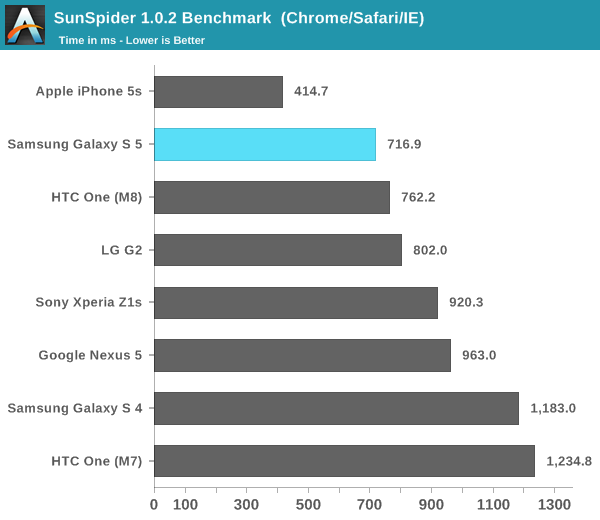
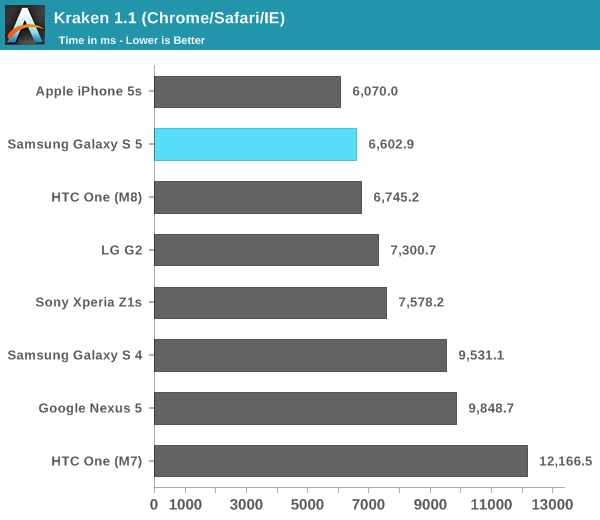
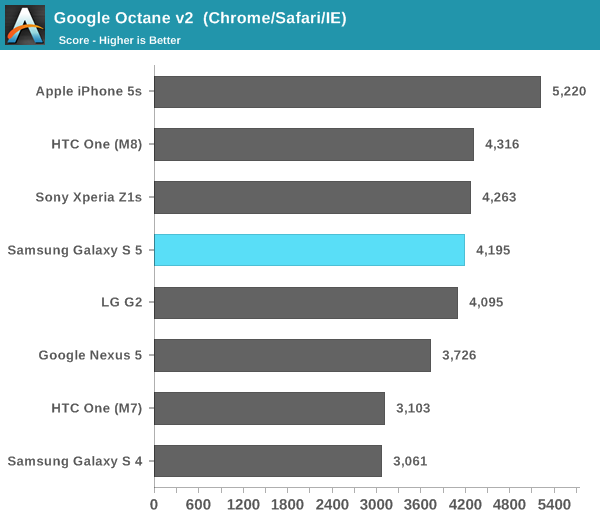
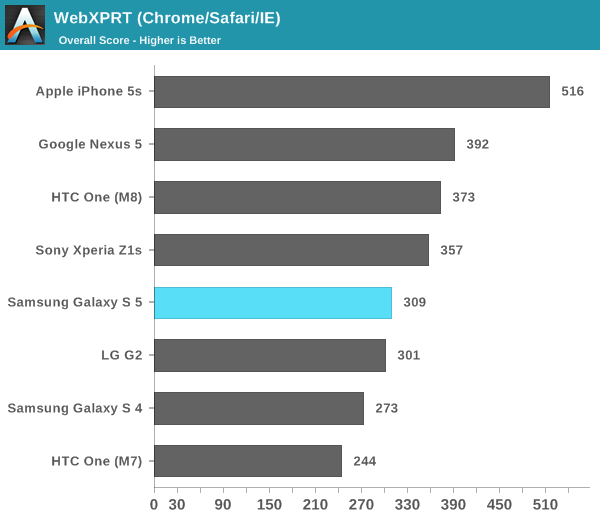
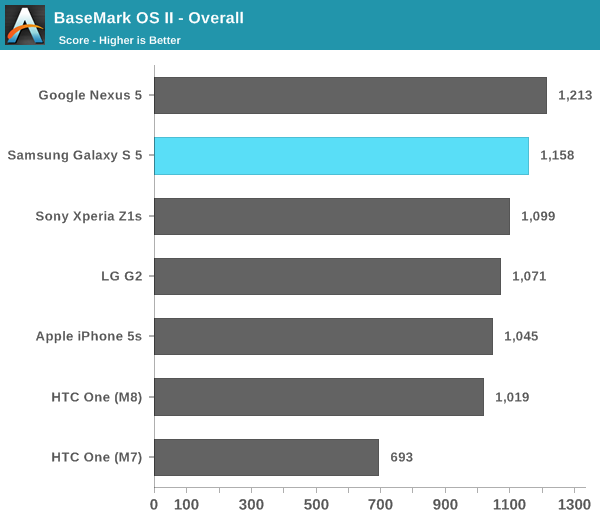
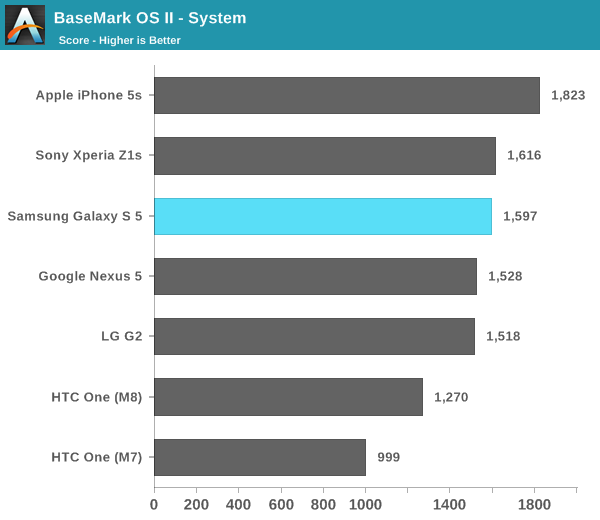
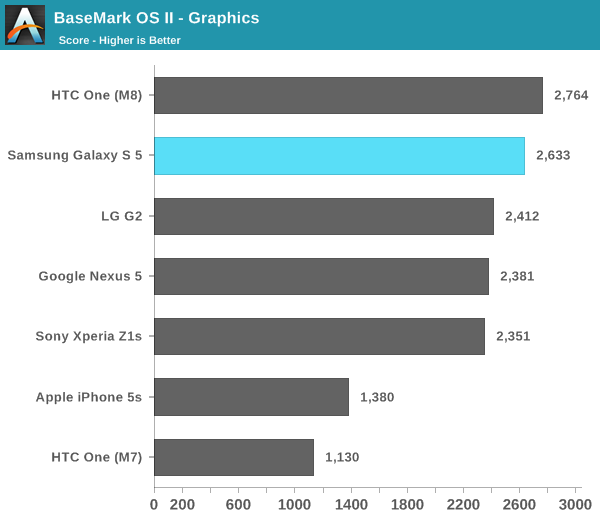

GPU Performance
GPU performance remains where we see the biggest benefit from Snapdragon 801 vs. 800, and since the GPU gains are almost entirely due to frequency scaling it's not too surprising that the M8 pulls ahead of the GS5 here in most cases.
There aren't any surprises here. The Adreno 330 in the Galaxy S 5 is more than capable of driving the device's 1080p display both in current and near term future 3D games.
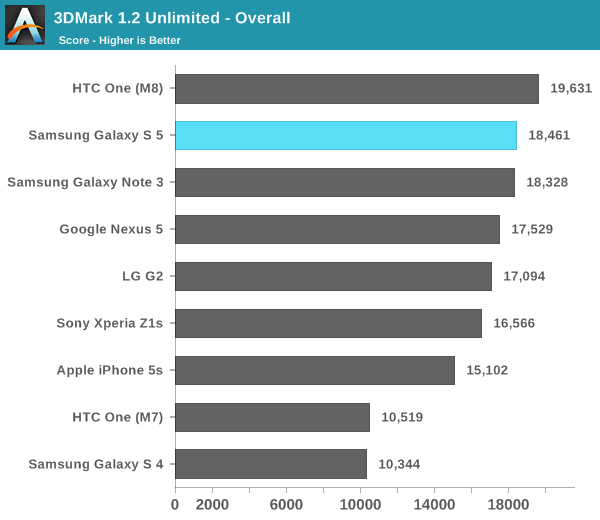
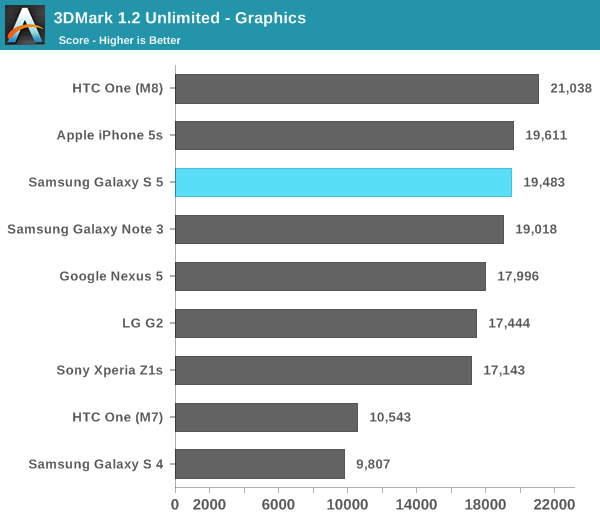
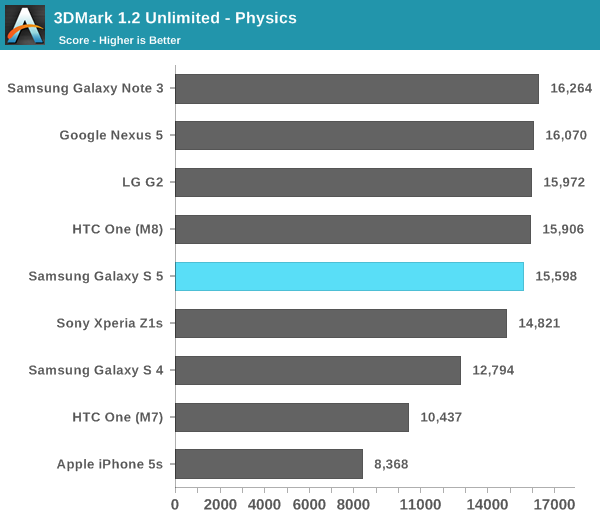
BaseMark X 1.1
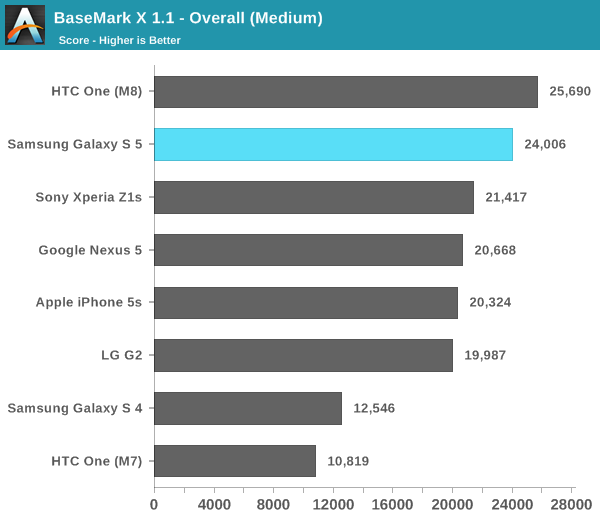

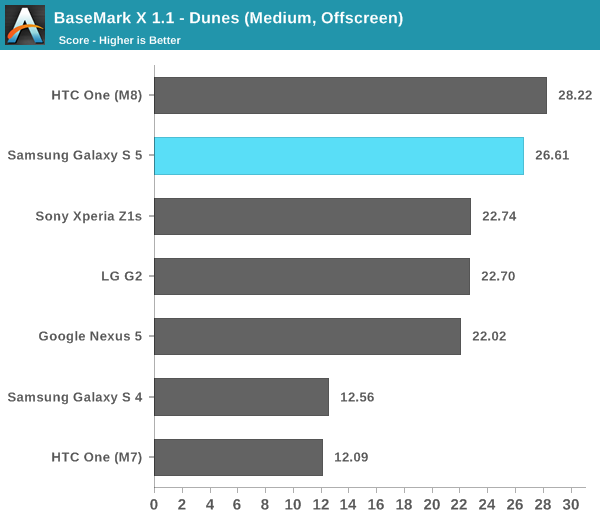
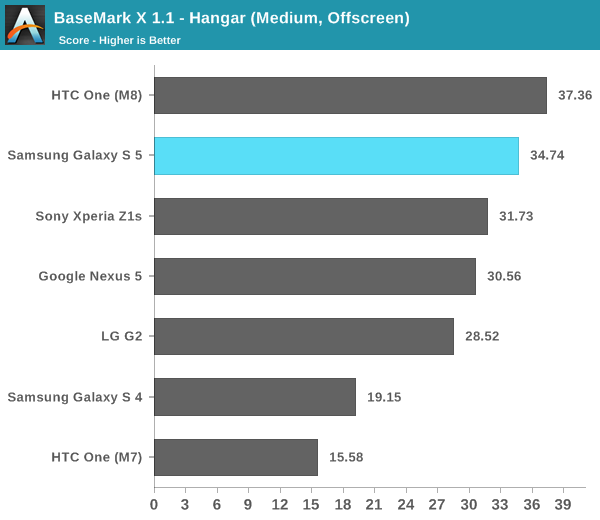

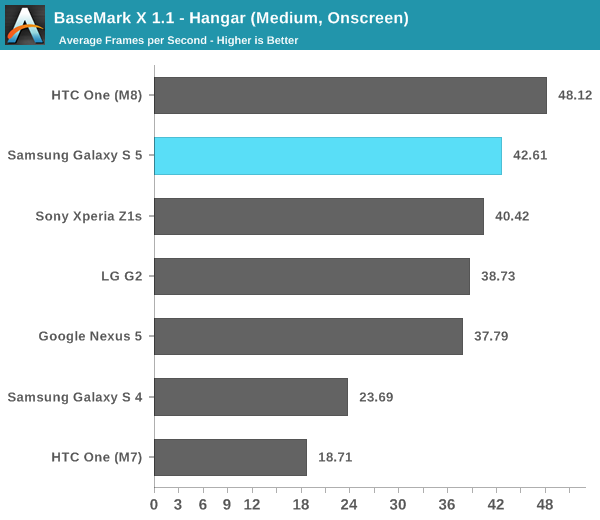
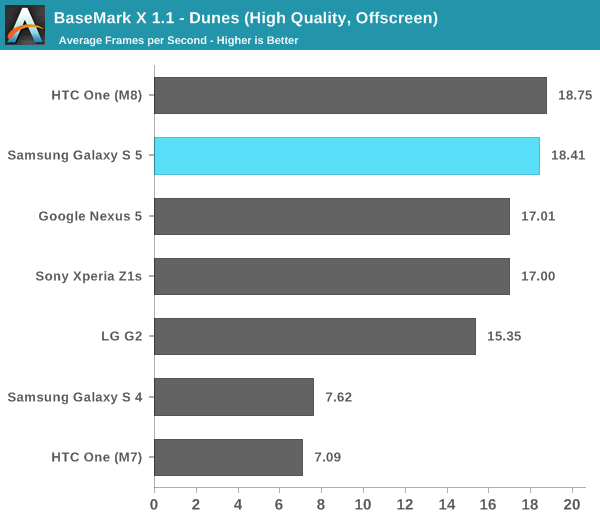
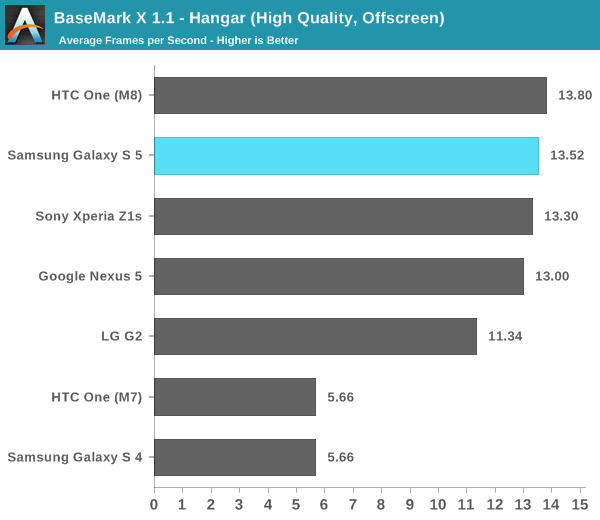
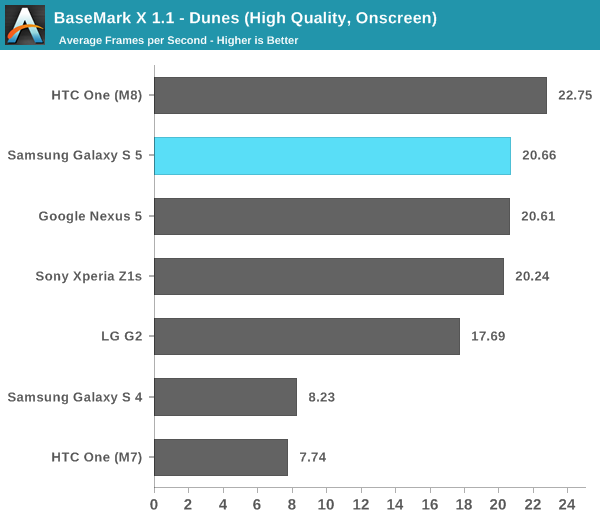
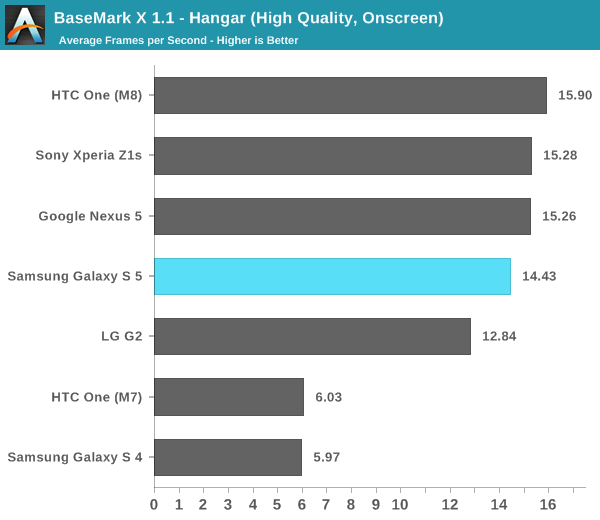
GFXBench 3.0
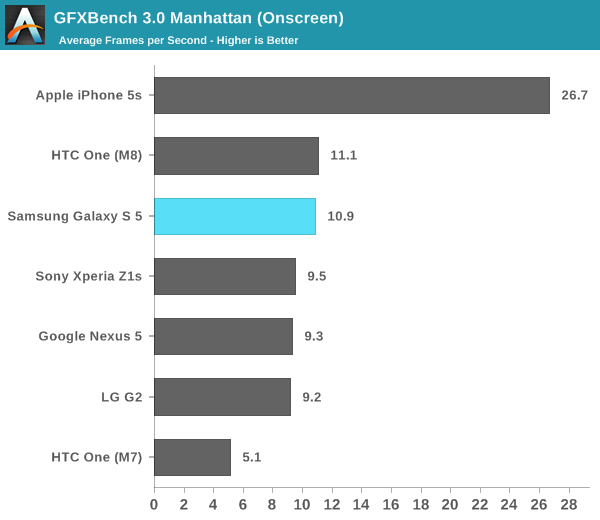
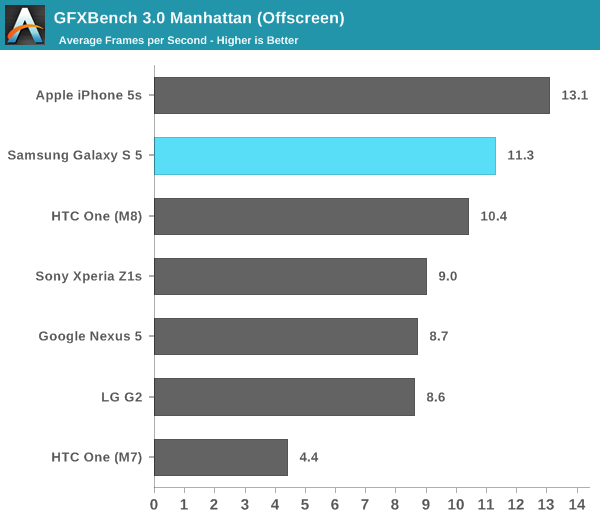
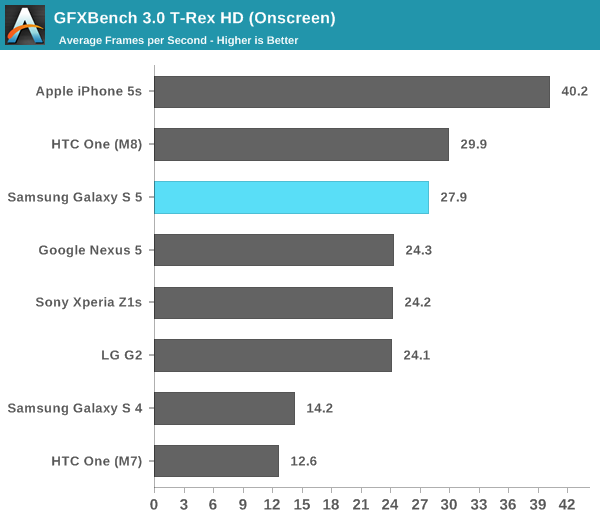
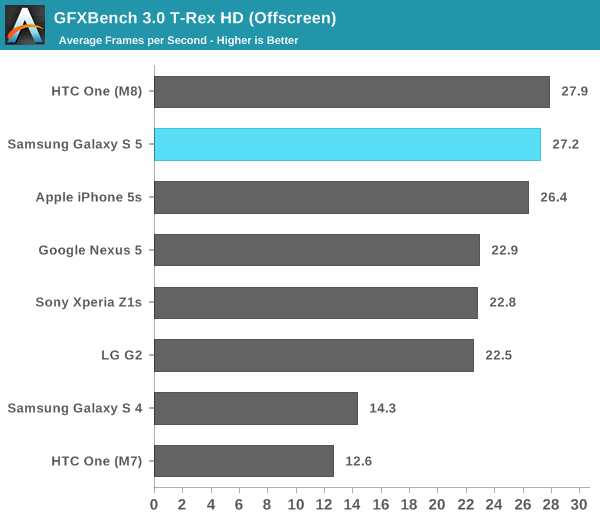

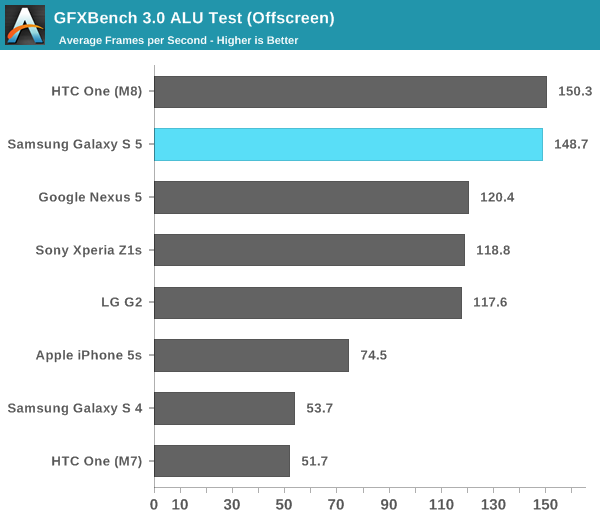


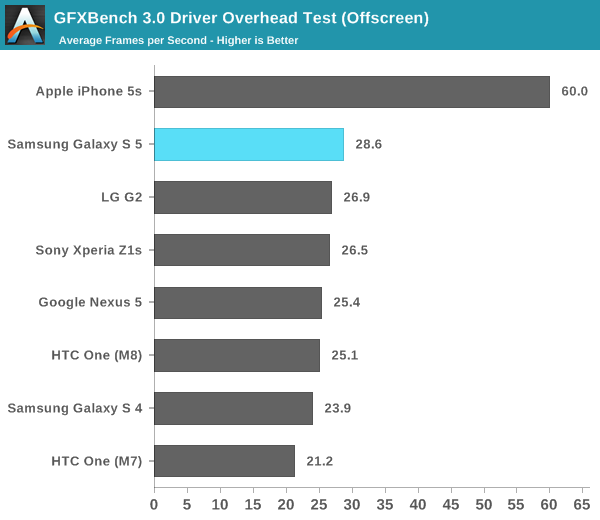
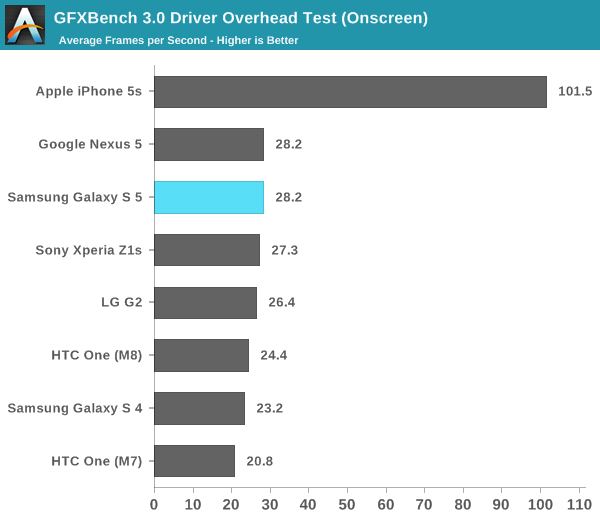
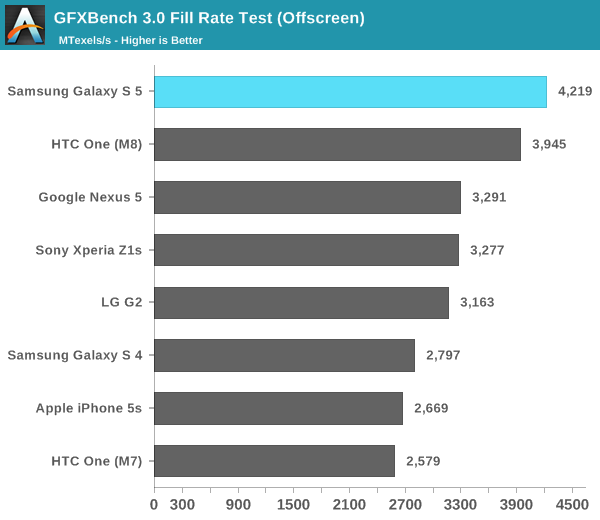
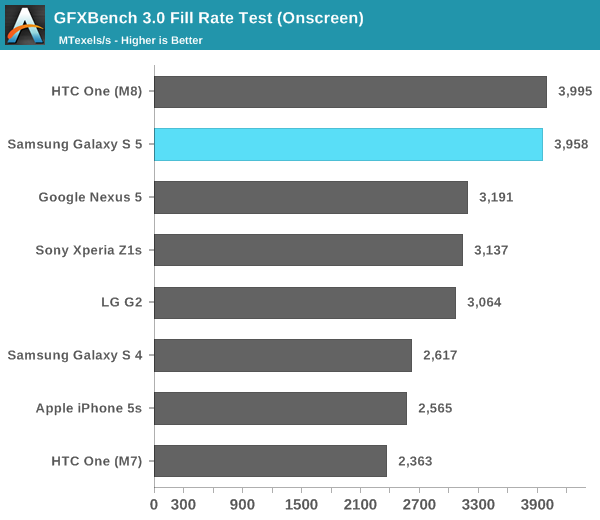
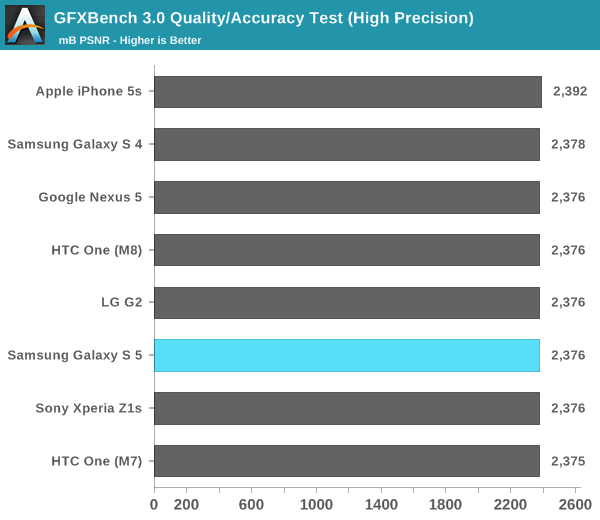
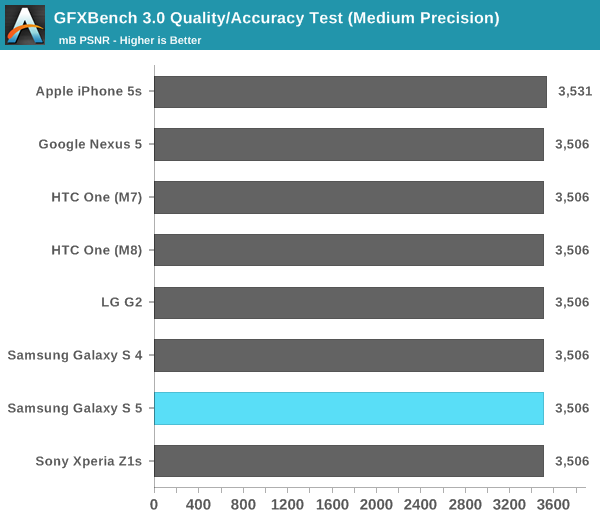
NAND Performance
The GS5 ships with 16GB or 32GB of NAND internally on an integrated eMMC device. Expansion is supported through a microSD card slot behind the removable back cover. Although the Snapdragon 801 inside supports eMMC 5.0, that alone doesn't guarantee a substantial increase in NAND performance. Keep in mind that most OEMs find multiple sources for their internal eMMC/NAND solutions, so what I'm testing here may only be representative of a portion of all GS5 devices.
Samsung sampled a 16GB GS5 review device. I put it through our usual random/sequential IO tests on a 100MB span of LBAs.
Random read performance is disappointing, it falls behind all modern devices we've tested. Random write performance is middle-of-the-road at best. It's unclear to me if this is a cost optimization or a lack of concern for NAND performance, but either way I'd rather see these metrics improve rather than regress.
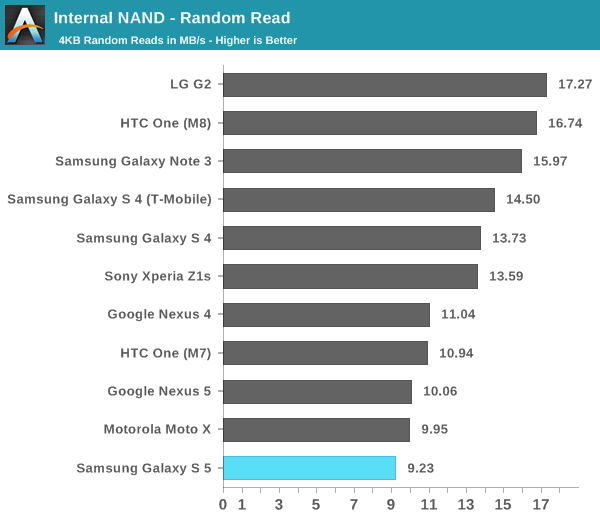
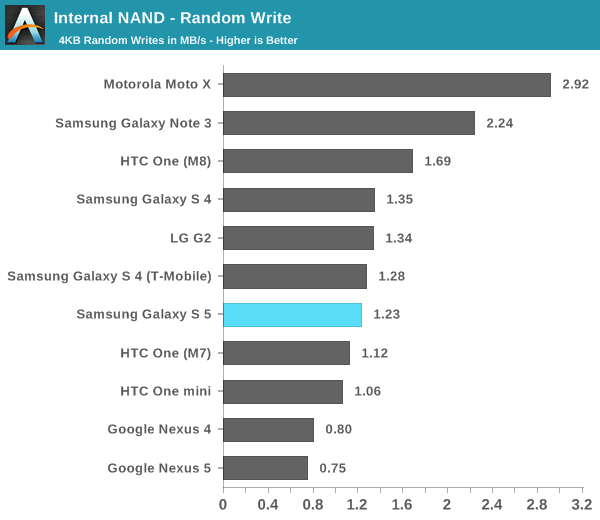
Sequential read/write performance both improve handsomely compared to the Galaxy S 4. I can see why Samsung would want to optimize for these two cases as they are quite common in regular usage, but random read/write performance can also significantly impact user experience.
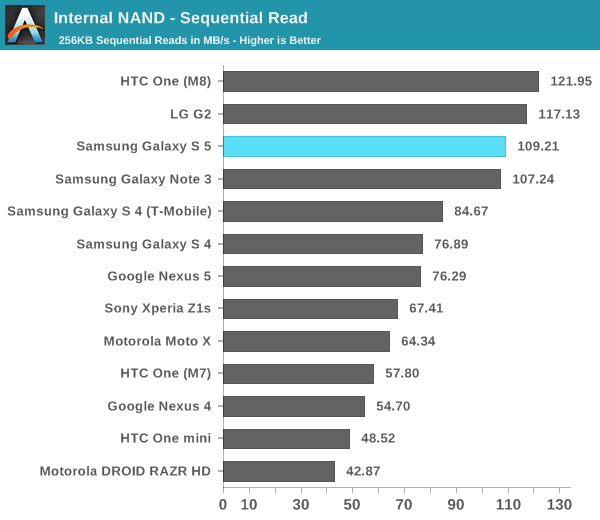
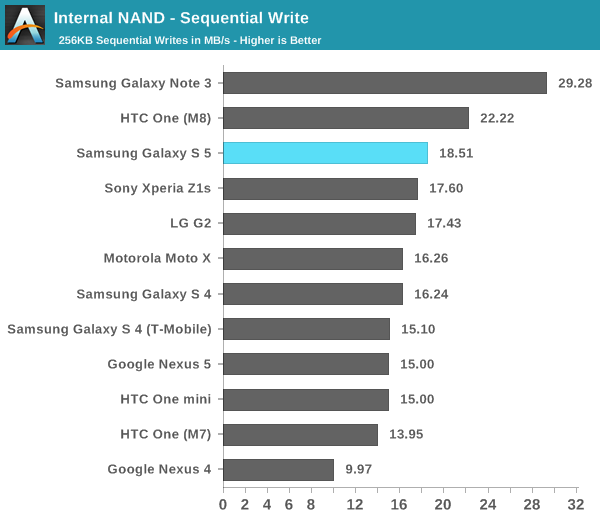










296 Comments
View All Comments
kmmatney - Tuesday, April 8, 2014 - link
My LG Optimus Pro G has a MicroSD slot, and a larger screen, and was a lot cheaper than the G2. That said, I won't buy an LG phone again - third party support is too weak, and there are some really annoying bugs in the software that haven't been fixed. I would like to go back to Apple, but need a larger screen, and enough space for 24 GB of music.Cheesew1z69 - Sunday, April 13, 2014 - link
Spreading your BS here too...how...cute.pppp6071 - Tuesday, April 8, 2014 - link
lol very funny. Ignoring all best aspects like battery life gorgeous screen and knock code and superb camera. just cause its not having SD card it sucks. I am doing just fine with my Nexus 5 32 GB phone.Alexey291 - Tuesday, April 8, 2014 - link
Very funny indeed. I have more music on my sd (thanks g-music subscription) than you have on your device.Lets not even look at apps and other media that I may have on there. But do go on.
Alexey291 - Tuesday, April 8, 2014 - link
that is to say I have more gigs of music on my sdSorry :)
Mondozai - Tuesday, April 8, 2014 - link
Streaming is possible. Welcome to 2014.SD cards are a requirement on tablets, not phones. If you need more space on your phone, you are not using it right.
Alexey291 - Tuesday, April 8, 2014 - link
Yes because endless free mobile data is a global thing. I travel a lot I don't like to pay roaming charges for streaming all around europe. I suggest you try it one day and see how that works for you.And I approve of the "you're not holding/using it right" comment at the end.
SD cards are a requirement on a device that I require to have an SD card. Simple as that. Besides why the hell does a tablet need an sd card more than a phone? Can't you by your own (silly) logic simply stream Blueray movies or something? Or is that going to be a 2015 thing?
twebber - Tuesday, April 8, 2014 - link
Yeah if you loose internet or signal while I'm watching a wide selection of movies an listening to an extended library you can enjoy your sad replay listVeruca5alt - Sunday, April 27, 2014 - link
Who cares??You use over 20GB of music everyday?
Pointless to carry around that much content.
Chaser - Tuesday, April 8, 2014 - link
Couldn't agree more. The G2 is the winner this round.